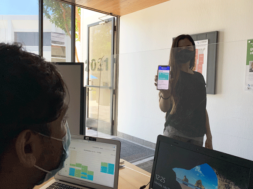
A New Look at Big Data in EDU
By Jennifer Flood, President, IntegriShield
Between now and 2025 your institution will graduate hundreds, if not thousands, of students. But are you equipped to track each of them, from enrollment through employment verification? Expanding on the 2015 APSCU breakout session, we will explore new methods for tracking the student lifecycle and reveal what works and what does not.
Big data is the thing that will keep schools in the “game” of an ever-increasingly competitive space. It is time for institutions to implement a data tracking solution that is secure, accessible, customizable and ultimately cost-effective. Continue reading to understand how you can better collect and analyze information across the student lifecycle.
Simply collecting data is pointless
Matt Killday, VP of Operations at Pinnacle Career Institute, explains that using data throughout the student lifecycle is critical.
Understand why students chose to look at your school. These are the same reasons they will eventually enroll and graduate — or not.
Several student questions may include:
- Which program do I like?
- Where do I want to attend classes?
- How long do I want to be in school?
- How I will I pay for it?
At first contact, keep it simple. Start by gathering the prospective student’s basic information such as: name, email, address, phone and program of interest. Collecting information will benefit both parties, but it is easier to do when there is more of an established relationship. Killday encourages teams to make a point of digging deeper during the appointment to gain more detailed and intimate data. Have a process in place to collect this information. You will want to understand each potential student’s motivations, personality, support structure, etc. At this point in the student lifecycle collecting data shifts to using data. Securely store your information to be easily accessible.
Schools do a great job in the admissions processes of learning about a student in order to solidify their commitment. A disconnect occurs when they do not carry that information or practices to any other department. Follow-up with your prospective students and share this information across silos. Use what you know and you will be on the path to improving the way you track and monitor both current and graduated students.
The illusion
George Bernard Shaw once said, “The single biggest problem in communication is the illusion that it has taken place.” This is extremely relevant to the orientation phase. Return the favor and do not assume. Killday reminds us that the orientation is an opportunity for people that will work closely with students to share information about themselves — not just where the restrooms are.
Your job is not done after the student is enrolled and his or her orientation is complete.
Many schools make the mistake of no longer collecting useable data on students after knowing them for just a few weeks.
The deepest relationships with students are built after the admissions process. Continue learning and dissecting who each student is — while simultaneously enhancing your database.
Keep information flowing
IntegriShield we help clients understand that data collection does not end once a prospect becomes a student. All relevant information collected and maintained post enrollment works for you in the future. A vital piece of information to post-graduate searches is collecting medical emergency contact information, or next of kin. The more information the school maintains, the easier your future reporting efforts become. Keeping a student’s current employment on file can also help tremendously after graduation. Often students will be promoted within an organization, or their former job may know their current employer.
Do you know how to reach each student during a certain time of day? Collecting pre-graduate status information can help. Document school and work schedules in a central information system to help when financial aid or Registrar needs to contact a student.
There are also exceptions to current enrollment numbers. Keep record of students who are incarcerated, deployed, dropped from school or simply took a medical leave of absence due to sickness or possible maternity. Various reasons may cause a student to extend his or her program length or drop from a course.
After graduation the tracking responsibilities of your institution are ongoing. Career colleges have been called into question by the policy community regarding the quality of data used to estimate the value of student outcome. To restore credibility, some accrediting bodies have introduced an improved placement verification and quality assurance process. Make sure your third party provider is educated on the industry variations in reporting and requirements.
Apply the principles
Gainful employment and verification of employment requirements are getting incredibly strict across the country. Knowing your specific accrediting body requirements and state laws are imperative for proper data collection and storage. The more data a school collects across the lifetime of the student, the easier and more sound the required reporting. In the past, data collection has been spread sheets on different machines, file cabinets and scribbled notes. Move your school into the competitive education space by applying data collection principles to student information. Properly prepare your staff for regulatory reporting.
Following graduation, reporting is required for all relevant accrediting bodies. This reporting must be submitted with specific criteria and formatted in such a way that is approved by each associated body. Several status data points include:
- Post-graduation
- Employed
- Employed in the field
- Searching for employment
- Qualify for waiver of placement
- Awaiting licensing
- Etc.
Help categorize your report preparation through simplified data points. Additionally, fitting graduates in data fields will assist in answering query points from data sets. For example, an institution should have data sets answer questions such as; “How many students graduated on time from the HVAC program and received jobs within 30 days of graduation?”
Properly formulated data sets will answer specific inquiries, making the admissions and career services departments’ jobs much easier and more accurate when reporting is due to the organizations accrediting bodies.
Remember waiver of placement
Not every student who graduates will qualify for a placement status. Thankfully, we can categorize these students in a Waiver of Placement category. Some of the waivers will vary with each accrediting body or state requirement. Please be sure to check with the proper authoritative body before formulating your waivers for data importing and reports. Typically, waivers of placement include: death, medical disability, deployment, incarceration, and business owners. A waiver of placement allows an institution to not “count” the student against the gainful employment numbers needed to meet the minimum requirements. These students will not count as placed in their fields, but will meet an exception for reporting purposes. Knowing ongoing facts, such as the military status of student (or former criminal record) could point the placement statistics provider to the right place if a graduate becomes difficult to locate.
Better outcomes from better data
Knowing the licensing status of graduates can help on various levels. Some schools have used the licensing status phase as a way to implement programs that help more students take and pass licensing tests. A significant percentage of graduates will often not sit for licensing tests although it is required to gain employment in their field of study. There are various reasons why a graduate would or would not sit for a required test for employment. Categorizing this information allows the school to build notification systems, create study programs post grad, and maintain contact information for employment after licensing.
Once a student has completed all required courses, taken any applicable tests and obtained employment in his or her field of study, this information must be recorded. Additionally, it must be consistently updated and reported to the proper authorities. Maintaining concise data on your graduates makes this an easier process. IntegriShield offers a Verification of Employment form in the students’ graduation packets. Notify the student that upon employment, they are encouraged to notify the school as quickly as possible. Keeping a positive relationship with your graduates through graduation makes this step even easier.
Data beyond graduation
There are a myriad of ways to keep collecting data on your post-grad students. Your graduates are your greatest source of referrals. Keep the door open for grads to recommend, coworkers, children and friends to your programs by maintaining a positive relationship even after graduation.
During the employment verification process, it is important to make sure your career services department, or your third party provider, is also working diligently to build relationships with employers and maintain positive rapport with graduates. Employer surveys are a great way to get feedback on your graduates and help build better programs. In return, the relationships with employers will hopefully create a positive flow of program graduates to new hires in their companies. Some of your graduates may also run their own companies at some point. Remaining in contact with these students will open more avenues for employment for future graduates.
Big data principals are not just fields to fill-in and questions to ask.
Technology and data allow your school to consistently build relationships and streamline processes for reporting.
If you have more questions about graduate placement, gainful employment, big data or simple, affordable student information systems, contact me at jflood@integrishield.com.

Jennifer Flood is the President of IntegriShield, the only service that identifies and remediates marketing infractions and compliance violations. Jennifer has a background in plaintiff’s law and subprime finance compliance. She uses her expertise in compliance law by assisting and advising clients in day-to-day challenges related to advertising, admissions, accreditation and data analytics. Dedicated to the growth of her industry and community, she provides compliance expertise as an industry contributor to various publications nationwide and offers a free webinar series through IntegriShield.com.
Contact Information:Jennifer Flood // President // IntegriShield // 816-994-1313 // jflood@integrishield.com










